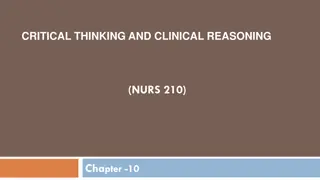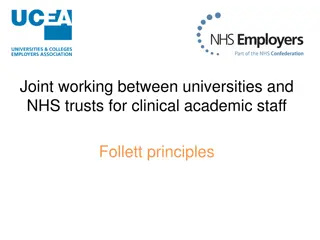Enhancing Clinical Reasoning Training in Medical Education
Integrating research activities into educational programs is essential for advancing clinical reasoning training in medical education. This study explores different teaching approaches for clinical reasoning, focusing on addressing traditional teaching drawbacks and implementing simulation encounters. The case study of a patient presenting with respiratory symptoms prompts learners to consider diagnostic hypotheses, fostering critical thinking and decision-making skills.
Download Presentation

Please find below an Image/Link to download the presentation.
The content on the website is provided AS IS for your information and personal use only. It may not be sold, licensed, or shared on other websites without obtaining consent from the author.If you encounter any issues during the download, it is possible that the publisher has removed the file from their server.
You are allowed to download the files provided on this website for personal or commercial use, subject to the condition that they are used lawfully. All files are the property of their respective owners.
The content on the website is provided AS IS for your information and personal use only. It may not be sold, licensed, or shared on other websites without obtaining consent from the author.
E N D
Presentation Transcript
The challenge of integrating research activities into a regular educational program An example of a study on approaches for the teaching of clinical reasoning Walter van den Broek, S lvia Mamede Institute of Medical Education Research Rotterdam
A bit of background Training of clinical reasoning at ErasmusMC Current format:
How to teach clinical reasoning: A bit of background Traditional teaching of clinical reasoning: Clinical rotations Drawbacks: limited practice, suboptimal supervision and feedback Many medical schools: clinical reasoning courses
A bit of background Clinical reasoning courses: Primary learning resource: clinical cases Different formats of presentation Most prevalent approach: simulation of a real clinical encounter ( serial-cue ) (Schmidt & Mamede, 2015)
The patient is an obese 56-year-old woman, mother of four children, without co-morbidities. She presents with a cough of one-week duration initially with green expectoration that became yellowish in the last days.
The patient is an obese 56-year-old woman, mother of four children, without co-morbidities. She presents with a cough of one-week duration initially with green expectoration that became yellowish in the last days. Which diagnostic hypotheses come to your mind?
The patient is an obese 56-year-old woman, mother of four children, without co-morbidities. She presents with a cough of one-week duration initially with green expectoration that became yellowish in the last days. Which diagnostic hypotheses come to your mind? Flu Community-acquired pneumonia Foreign body aspiration
The patient is an obese 56-year-old woman, mother of four children, without co-morbidities. She presents with a cough of one-week duration initially with green expectoration that became yellowish in the last days. Which diagnostic hypotheses come to your mind? Flu Community-acquired pneumonia Foreign body aspiration What else would you like to know (and why)?
The patient is an obese 56-year-old woman, mother of four children, without co-morbidities. She presents with a cough of one-week duration initially with green expectoration that became yellowish in the last days. Which diagnostic hypotheses come to your mind? Flu Community-acquired pneumonia Foreign body aspiration What else would you like to know (and why)? Fever? Malaise? Wheezing?
Why serial-cue may not be better Medical expertise development: stages theory
Why serial-cue may not be better Medical expertise development: stages theory Other approaches have been empirically investigated: Self-explanation Structured reflection
Students (8thgrade) generating self-explanations while reading a text on the circulatory system Fragment of the to-be-learned material: The septum divides the heart lengthwise into two sides. The right side pumps blood to the lungs, and the left side pumps blood to the other parts of the body Fragment of a student s self-explanation: So the septum is like a wall that divides the heart into two parts it kind of like separates it so that the blood doesn t get mixed up . (Chi 1994)
Self-explanation in medical education While diagnosing clinical cases, students read the case and explain to themselves: how the clinical findings could have been produced how these signs and symptoms relate to each other how they relate to the possible diagnoses (Chamberland et al., 2011; 2013; 2015):
A 70-year-old woman presents with progressive jaundice. The patient presents a gradual yellow discoloration of her skin over three weeks with nausea. She noticed that her urine has become dark.. She has no abdominal pain other than vague epigastric discomfort and nausea. She reports no diarrhea and her stools are normal. She had low grade fever and is complaining of joint pain over the last week
A 70-year-old woman presents with progressive jaundice. The patient presents a gradual yellow discoloration of her skin over three weeks with nausea. She noticed that her urine has become dark.. She has no abdominal pain other than vague epigastric discomfort and nausea. She reports no diarrhea and her stools are normal. She had low grade fever and is complaining of joint pain over the last week A 70-year-old woman presents with progressive jaundice. The patient presents a gradual yellow discoloration of her skin over three weeks with nausea. She noticed that her urine has become dark. It might be because there is more bilirubine in the urine. She has no abdominal pain other than vague epigastric discomfort and nausea. Well, that doesn t sound very specific might be related to the liver? She reports no diarrhea and her stools are normal. I remember, sometimes in jaundice, the stools become more pale in fact when there is no bilirubine when there is like an obstruction in the biliary track. So it might not be the case here. She had low grade fever and is complaining of joint pain over the last week. Joint pain?...I don t actually see how this might be related to the problem
Structured Reflection Instructions to participants: Read the case and provide a diagnostic hypothesis Which signs and symptoms support your diagnostic hypothesis (Dx)? List them. Which signs and symptoms do not support your Dx? List them. Which findings should have been there if your Dx is correct and are not? List them. Is there an alternative Dx? Write it down and start over. Now, what is your decision on the most likely diagnosis? (Mamede et al, 2012; 2014)
A 48-year-old man, previously healthy, presented to the emergency department after a sudden episode of cough, dyspnea, and a sensation of chest tightness that happened while he was climbing the stairs in his apartment. The patient reports two similar episodes during the last month, one when he was cutting threes in the garden and the other while he was repairing a sport court. In all occasions, the symptoms stopped spontaneously in a few hours, without any other intervention besides resting. Between the episodes, the patient felt well, without noticing restrictions to physical exercises. He smoked 30 cigarretes per day during around 20 years, but stoped completely 3 years ago. He does not use any medication and there is no hystory of allergy. Family history: His father died due to myocardial infarction when he was 60. Physical examination: BP: 120/80mmHg Pulse: 90 bpm Temp:36,50oC Respiratory: 20rpm Patient appeared healthy but in respiratory distress. Jugular veins: no abnormalities. Heart: auscultation without abnormalities. Lungs: bilateral ronchi and whezees. No other abnormalities in the physicial examination. Laboratory data: Ht: 45%; Leukocytes: 13,5 x 109/L, 82% neutrophils, 11% lymphocytes, 5% monocytes, 2% eosinophyl. Electrolytes, ureum, kreatinine, glucose: values within normal range. Blood gases (patient breathing environmental air) - pO2: 6,9 kPa, pCO2: 4,6 kPa, pH: 7.44. ECG: without abnormalities except non-specific alterations in the ST-segment and T waves. Blood gases in a subsequent measurement (patient breathing environmental air), after em nova mensura o, after symptoms remission - pO2: 13,5 kPa, pCO2: 4.3 kPa, pH: 7.41. X-Ray: Thorax: normal cardiac area, clear lung fields. No signs of congestive cardiac insufficiency.
Diagnostic hypothesis Findings that speak in favor of this diagnostic hypothesis Chest tightness Dyspnea Cough Wheezing Attacks after exercise or exposure to allergens Remission of symptoms Hypoxemia Attacks triggerred by exercise Age of onset middle-age Long time smoker Dyspnea Rhonchi Wheezing Hypoxemia Dyspnea Wheezing Chest tightness ECG Smoker Findings that speak against this diagnostic hypothesis Age of onset Without history of allergy No family history of asthma Findings expected to be present, but not described in the case Accessory muscles use Prolongation of expiratory phase 1 Asthma 3 Chronic obstructive pulmonary disease (COPD) Dyspnea and cough: episodic Sputum production Chronic, persistent cough Respiratory acidosis Decreased breath sounds 2 Pulmonary embolism Non-pleuritic chest pain (tightness) Normal respiratory frequency Jugular veins: no abnormalities X-Ray without abnormalities Tachypnea Hemoptysis History of risk factors for DVT (immobilization etc.)
Summing up serial-cue is the most prevalent teaching approach it does not seem consistent with how clinical reasoning is learned the scarce empirical research available has investigated (and supported) other approaches
Studies on approaches for teaching clinical reasoning Purpose: To compare the effectiveness of three different teaching approaches (self-explanation, structured reflection, serial-cue) in different phases Design: two-phase experiment, with a learning phase and a one-week later test phase Using sessions of the regular curriculum
(385 2nd-year medical students) Week 1 Learning phase Structured reflection (76) Differential diagnosis (89) Self- Serial-cue (74) explanation (85) Week 3 Test phase Diagnostic test (324)
Assessment of prior knowledge and clinical experience (385 2nd-year medical students) Week 1 Learning phase Structured reflection Differential diagnosis Self- Serial-cue explanation Week 3 Test phase Diagnostic test (324)
Influencing factors Initial competence Participants perceptions of the study Unusual format, deviating from familiar tasks Different environment Teachers unaware of the study Insufficient previous information Participants different reactions
Influencing factors Compliance with treatment: Time on task in the learning phase: Previous studies*: 7 min Self-explanation: 27/85; Reflection: 41/76 Amount of reflection (preliminary analysis) *Chamberland et al., 2011; Mamede et al. 2012, 2014






















